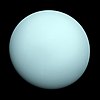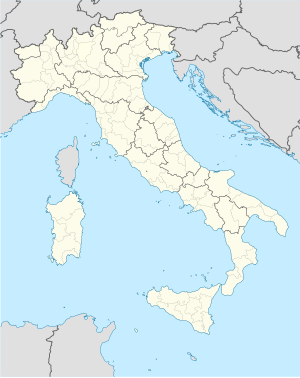데스데모나(달)
Desdemona (moon) 데스데모나의 발견 이미지 | |
| 디스커버리 | |
|---|---|
| 검색 대상 | 스티븐 P. Synnott / Voyager |
| 발견일자 | 1986년 1월 13일 |
| 지정 | |
지정 | 천왕성 X호 |
| 발음 | /dɛzdəˈmoʊnə/[1] |
| 형용사 | 데스데모난,[2] 데스데모니아,[3] 데스데모난[4] /dɛzdəmoʊn(i)ən/ |
| 궤도 특성 | |
평균 궤도 반지름 | 62,658.364 ± 0.047km[5] |
| 편심성 | 0.00013 ± 0.000070[5] |
| 0.473649597 ± 0.000000014 d[5] | |
| 기울기 | 0.11252 ± 0.037°(천왕성의 적도까지)[5] |
| 의 위성 | 천왕성 |
| 물리적 특성 | |
| 치수 | 90 × 54 × 54 km[6] |
평균 반지름 | 32.0 ± 4km[6][7][8] |
| ~14,500km2[a] | |
| 볼륨 | ~12만 km3[a] |
| 미사 | ~1.8×10kg17[a] |
평균 밀도 | ~1.3 g/cm3 (크기)[7] |
| ~0.011m/s2[a] | |
| ~0.027km/s[a] | |
| 동기식의[6] | |
| 영점[6] | |
| 알베도 | |
| 온도 | ~64K[a] |
데스데모나는 천왕성의 내부 위성이다. 1986년 1월 13일 보이저 2호가 촬영한 이미지에서 발견되었으며, 임시 명칭 S/1986 U 6. 데스데모나는 윌리엄 셰익스피어의 희곡 오델로에서 오델로의 아내의 이름을 따서 명명되었다.[10] 천왕성 X로 지정되기도 한다.[11]
데스데모나는 비앙카, 크레시다, 줄리엣, 포르티아, 로잘린드, 큐피드, 벨린다, 페르디타도 포함된 포르티아 위성그룹에 속한다.[9] 이 위성들은 궤도와 광도 특성이 비슷하다.[9] 궤도 외에 반경 32km[6],[5] 기하학적 알베도 0.08[9] 등 사실상 데스데모나에 대해서는 알려진 바가 없다.
보이저 2 이미지에서는 데스데모나가 천왕성을 가리키는 주요 축인 긴 물체로 나타난다. 데스데모나의 프로이트 스피로이드 축의 비율은 0.6 ± 0.3이다.[6] 그것의 표면은 회색이다.[6]
데스데모나는 앞으로 1억년 이내에 이웃한 달 중 하나인 크레시다나 줄리엣과 충돌할지도 모른다.[12]
참고 항목
참조
주석
인용구
- ^ 벤자민 스미스 (1903) 세기 사전과 사이클로피디아
- ^ 해리스&라차리(1997) 셰익스피어 비판
- ^ 대일레더(2005) 인종차별, 여성혐오, 오델로 신화
- ^ 제노바(1997) 권력, 성별, 가치관
- ^ a b c d e Jacobson, R. A. (1998). "The Orbits of the Inner Uranian Satellites From Hubble Space Telescope and Voyager 2 Observations". The Astronomical Journal. 115 (3): 1195–1199. Bibcode:1998AJ....115.1195J. doi:10.1086/300263.
- ^ a b c d e f g Karkoschka, Erich (2001). "Voyager's Eleventh Discovery of a Satellite of Uranus and Photometry and the First Size Measurements of Nine Satellites". Icarus. 151 (1): 69–77. Bibcode:2001Icar..151...69K. doi:10.1006/icar.2001.6597.
- ^ a b c "Planetary Satellite Physical Parameters". JPL (Solar System Dynamics). 24 October 2008. Retrieved 12 December 2008.
- ^ a b Williams, Dr. David R. (23 November 2007). "Uranian Satellite Fact Sheet". NASA (National Space Science Data Center). Retrieved 12 December 2008.
- ^ a b c d Karkoschka, Erich (2001). "Comprehensive Photometry of the Rings and 16 Satellites of Uranus with the Hubble Space Telescope". Icarus. 151 (1): 51–68. Bibcode:2001Icar..151...51K. doi:10.1006/icar.2001.6596.
- ^ Smith, B. A. (January 16, 1986). "Satellites of Uranus". IAU Circular. 4164. Archived from the original on 5 November 2011. Retrieved 29 October 2011.
- ^ "Planet and Satellite Names and Discoverers". Gazetteer of Planetary Nomenclature. USGS Astrogeology. July 21, 2006. Retrieved 6 August 2006.
- ^ Duncan, Martin J.; Lissauer, Jack J. (1997). "Orbital Stability of the Uranian Satellite System". Icarus. 125 (1): 1–12. Bibcode:1997Icar..125....1D. doi:10.1006/icar.1996.5568.
외부 링크
- NASA 태양계 탐사에 의한 데스데모나 프로파일
- 천왕성의 알려진 위성들 (스콧 S. 셰퍼드)





